
Porcelain is a ceramic material made by heating substances, generally including materials such as kaolinite, in a kiln to temperatures between 1,200 and 1,400 °C. The strength, and translucence of porcelain, relative to other types of pottery, arises mainly from vitrification and formation of the mineral mullite within the body at these high temperatures. Though definitions vary, porcelain can be divided into three main categories: hard-paste, soft-paste and bone china. The category that an object belongs to depends on the composition of the paste used to make the body of the porcelain object and the firing conditions.
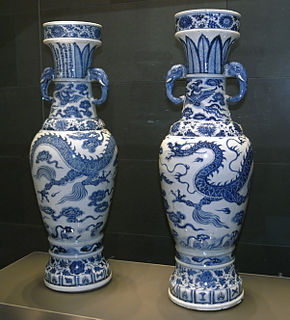
The Percival David Foundation of Chinese Art holds a collection of Chinese ceramics and related items assembled by Percival David that are on permanent display in a dedicated gallery in Room 95 at the British Museum. The Foundation's main purpose is to promote the study and teaching of Chinese art and culture. The collection consists of some 1,700 pieces, mostly of Song, Yuan, Ming and Qing dynasty porcelain from the 10th century to the 18th. It includes a painting, Scroll of Antiquities.

Kraak ware or Kraak porcelain is a type of Chinese export porcelain produced mainly in the late Ming Dynasty, in the Wanli reign (1573–1620), but also in the Tianqi (1620–1627) and the Chongzhen (1627–1644). It was among the first Chinese export wares to arrive in Europe in mass quantities, and was frequently featured in Dutch Golden Age paintings of still life subjects with foreign luxuries.

Soft-paste porcelain is a type of ceramic material in pottery, usually accepted as a type of porcelain. It is weaker than "true" hard-paste porcelain, and does not require either the high firing temperatures or the special mineral ingredients needed for that. There are many types, using a range of materials. The material originated in the attempts by many European potters to replicate hard-paste Chinese export porcelain, especially in the 18th century, and the best versions match hard-paste in whiteness and translucency, but not in strength. But the look and feel of the material can be highly attractive, and it can take painted decoration very well.

Hard-paste porcelain, sometimes "true porcelain", is a ceramic material that was originally made from a compound of the feldspathic rock petuntse and kaolin fired at very high temperature, usually around 1400 °C. It was first made in China around the 7th or 8th century, and has remained the most common type of Chinese porcelain.

The Clockmakers’ Museum in London, England, is believed to be the oldest collection specifically of clocks and watches in the world. The collection belongs to and is administered by the Clockmakers’ Charity, affiliated to the Worshipful Company of Clockmakers, founded in 1631 by Royal Charter. Since 2015 it has been housed in a gallery provided by the Science Museum in South Kensington, having formerly been located in the Guildhall complex in the City of London since 1874, where it first opened to the public. Admission is free.

Transfer printing is a method of decorating pottery or other materials using an engraved copper or steel plate from which a monochrome print on paper is taken which is then transferred by pressing onto the ceramic piece. Pottery decorated using the technique is known as transferware or transfer ware.

Mintons was a major company in Staffordshire pottery, "Europe's leading ceramic factory during the Victorian era", an independent business from 1793 to 1968. It was a leader in ceramic design, working in a number of different ceramic bodies, decorative techniques, and "a glorious pot-pourri of styles - Rococo shapes with Oriental motifs, Classical shapes with Medieval designs and Art Nouveau borders were among the many wonderful concoctions". As well as pottery vessels and sculptures, the firm was a leading manufacturer of tiles and other architectural ceramics, producing work for both the Houses of Parliament and United States Capitol.
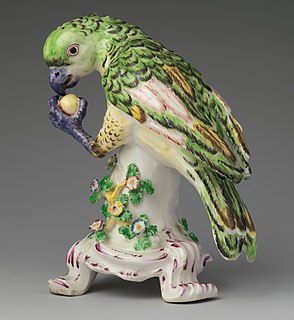
The Bow porcelain factory was an emulative rival of the Chelsea porcelain factory in the manufacture of early soft-paste porcelain in Great Britain. The two London factories were the first in England. It was originally located near Bow, in what is now the London Borough of Tower Hamlets, but by 1749 it had moved to "New Canton", sited east of the River Lea, and then in Essex, now in the London Borough of Newham.
Lars Broholm Tharp is a Danish-born British historian, lecturer and broadcaster, and one of the longest running 'experts' on the BBC antiques programme, Antiques Roadshow, first appearing in 1986.
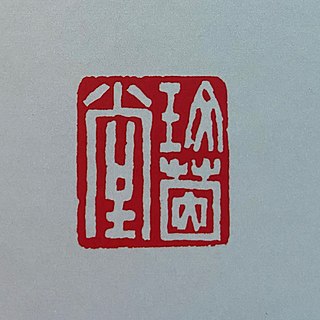
The Meiyintang Collection is a privately owned assembly of Chinese ceramics, porcelain and bronzes, which has been hailed as one of the finest private collections of Chinese porcelain in the Western world. Meiyintang 玫茵堂, "Hall among Rosebeds", is the adopted Chinese studio name of the collection.
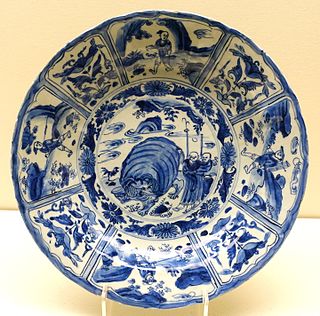
The Oriental Ceramic Society (OCS) is one of the leading international societies for the study and appreciation of Asian art, with a special interest in ceramics. However its wider focus is the study and appreciation of all aspects of oriental art, and over the last 90 years has served as one of the main bodies assisting the understanding of oriental art, and oriental ceramics in particular, by means of organising regular meetings, lectures and publications.

Henri Vever (1854–1942) was one of the most preeminent European jewelers of the early 20th century, operating the family business, Maison Vever, started by his grandfather. Henri was also a collector of a broad range of fine art, including prints, paintings, and books of both European and Asian origin. By the 1880s, Vever became one of the earliest Europeans to formally collect Japanese ukiyo-e woodblock prints, purchasing extensively from dealers such as Hayashi Tadamasa. He was a member of Les Amis de l'Art Japonais, a group of Japanese art enthusiasts including Claude Monet, that met regularly to discuss Japanese prints and other works over dinner.

Paul Cummins MBE is an English artist from Chesterfield, Derbyshire, who produces landscape installations using ceramic flowers.

Ru ware, Ju ware, or "Ru official ware" is a famous and extremely rare type of Chinese pottery from the Song dynasty, produced for the imperial court for a brief period around 1100. Fewer than 100 complete pieces survive, though there are later imitations which do not entirely match the originals. Most have a distinctive pale "duck-egg" blue glaze, "like the blue of the sky in a clearing amongst the clouds after rain" according to a medieval connoisseur, and are otherwise undecorated, though their colours vary and reach into a celadon green. The shapes include dishes, probably used as brush-washers, cups, wine bottles, small vases, and censers and incense-burners. They can be considered as a particular form of celadon wares.
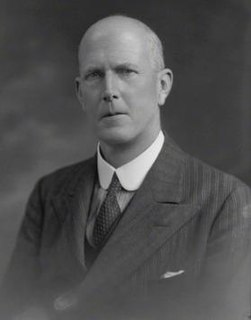
Robert Lockhart Hobson CB was a British civil servant and antiquarian. He was keeper of the Department of Ceramics and Ethnography at the British Museum and an authority on Far Eastern ceramics. He was noted for his cataloguing which The Times described as establishing firm facts for what had previously been "surmise and unproved tradition" and he was highly influential through his writing in the elevation of Chinese ceramics from craft works to the status of objects of fine art. He was president of the Oriental Ceramic Society from 1939 to 1942.
Bernard Rackham was an English writer and lecturer on ceramics and stained glass and spent his career as a curator at the Victoria and Albert Museum. He is known for his pioneering research on Italian maiolica.
Ryohei Ishikawa is a Japanese banker, the former chairman of Chubu Bank and the Teisan Group. He is a philatelist specialising in the stamps and postal history of the United States, Hawaii, and Hong Kong.
The Southeast Asian Ceramic Society (SEACS) was founded in 1969 in Singapore.

Donald Chisholm Towner was a collector and historian of British ceramics and painter. He is noted for his championship of creamware and his ground-breaking studies of this ceramic type in particular.















